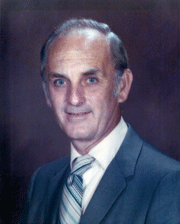 As one of the earliest hematologists in the region, Peyton Pratt, M.D., launched the state’s shift toward medical subspecialization.
As one of the earliest hematologists in the region, Peyton Pratt, M.D., launched the state’s shift toward medical subspecialization.
“I wanted to see patients and do pathology,” Dr. Pratt said. “That’s how I ended up in hematology.”
His focused decision, which evolved out of a fellowship experience, introduced Nebraskans to the concept of subspecialists in different clinical fields.
Today, the 1944 College of Medicine graduate is being honored with the 2005 College of Medicine Alumni Association’s Distinguished Alumni Award.
“As knowledge increased, subspecialization made it possible for physicians to spend more time learning their field more comprehensively,” Dr. Pratt said. “That made for marked improvements in health care.”
While in medical school in 1941, the Omaha native joined the U.S. Navy to finish his medical education. After graduating from UNMC, he went to Kings County Hospital in Brooklyn, N.Y., and continued his training with an internship and a pathology residency at Long Island College of Medicine Hospital.
Dr. Pratt performed his active duty with the Navy at the Philadelphia Naval Hospital. There, he met Dr. Phillip Custer of the University of Pennsylvania, whose monograph on the pathology of the bone marrow sparked Dr. Pratt’s interest in hematology.
After he finished his obligation to the Navy, Dr. Pratt returned to UNMC for his residency and then completed a fellowship in hematology at Cook County Hospital in Chicago under Dr. Steven Schwartz, who was the first fellow to train with Dr. William Damashek, dean of American hematology. In 1950, he returned to UNMC as a part-time faculty member, a role he filled until he retired in 1977.
In the course of his practice, Dr. Pratt had the opportunity to use a chemical called aminopterin, made by Lederle. Sidney Farber of Boston first used the drug for acute leukemia, making it the first chemical agent used in the treatment of malignancy. Dr. Pratt obtained it to treat a 6- or 7-year-old girl with acute leukemia. The girl had a partial remission and survived three to four months, far longer than the normal six-week life expectancy of the illness at that time.
Use of the drug marked the beginning of chemotherapy for all malignancies, Dr. Pratt said, because it demonstrated that malignant cells could be altered. It also showed that leukemia was a field where the effect of the drug could be closely followed by studying regular blood draws.
During the 60s, before DNA was available, Dr. Pratt tried a bone marrow transplant with the blood type techniques available at the time, he said.
After college, Dr. Pratt was honored to receive an invitation to join Sigma XI, a scientific research society, and later, Alpha Omega Alpha (AOA), the national honor medical society. “That was a great honor,” he said of the AOA induction. “I’d been retired a couple of years so that meant the AOA members thought my life accomplishments were adequate for admission.”
During his career, Dr. Pratt taught two of UNMC’s well-known faculty members: Jim Armitage, M.D., Shapiro Professor of Medicine and oncologist in UNMC’s Internal Medicine Department, and Mike Sorrell, M.D., Robert L. Grissom, M.D., Professor of Medicine.
“They were two of my students who turned out really well,” he said. “Although they both had self-starters of their own.”
Dr. Pratt’s inspiration came from his father, George Pratt, M.D., who taught internal medicine at UNMC in the mid-1900s. “Dad was one of my professors,” he said. “None of the doctors in the clinical fields who taught us, except the basic science fields, were paid. They all worked as volunteers.” Dr. Pratt was the first paid member of the faculty, he said, who wasn’t in the basic sciences.
Dr. Pratt retired from UNMC in 1977 with an uncertain future. His father had had a stroke when he was 58 and died three years later; his mother had died when she was 58. He retired at age 57, hoping for one good year. “That was 28 years ago,” he said.
Since then, he and his wife MaryLou have enjoyed traveling and spending time with their two daughters and son. Dr. Pratt was an ardent golfer, who stopped playing for health reasons. Today, he plays duplicate bridge and is a life and bronze master and close to becoming a silver master.
“Bridge keeps you mentally alert,” he said. “And there is always a higher goal ahead.”